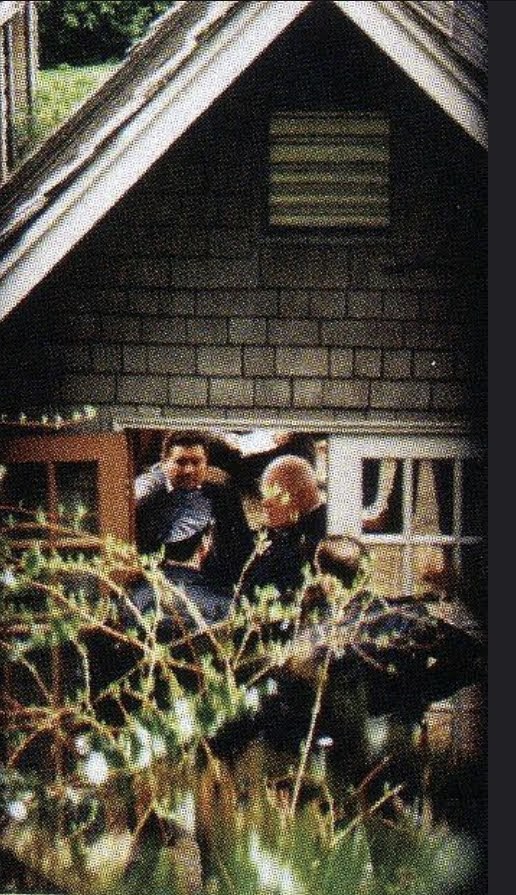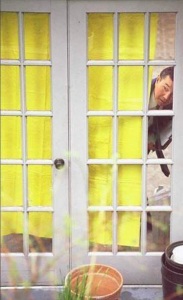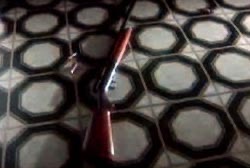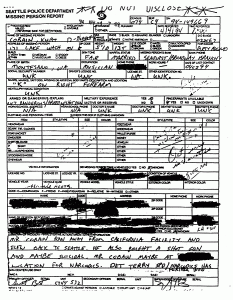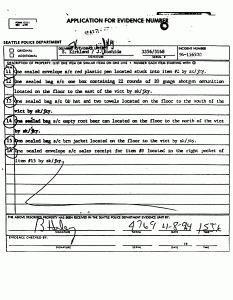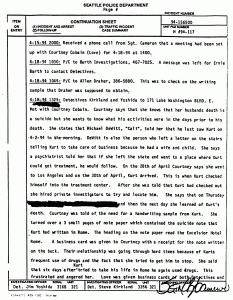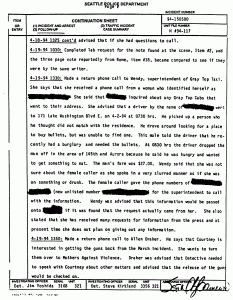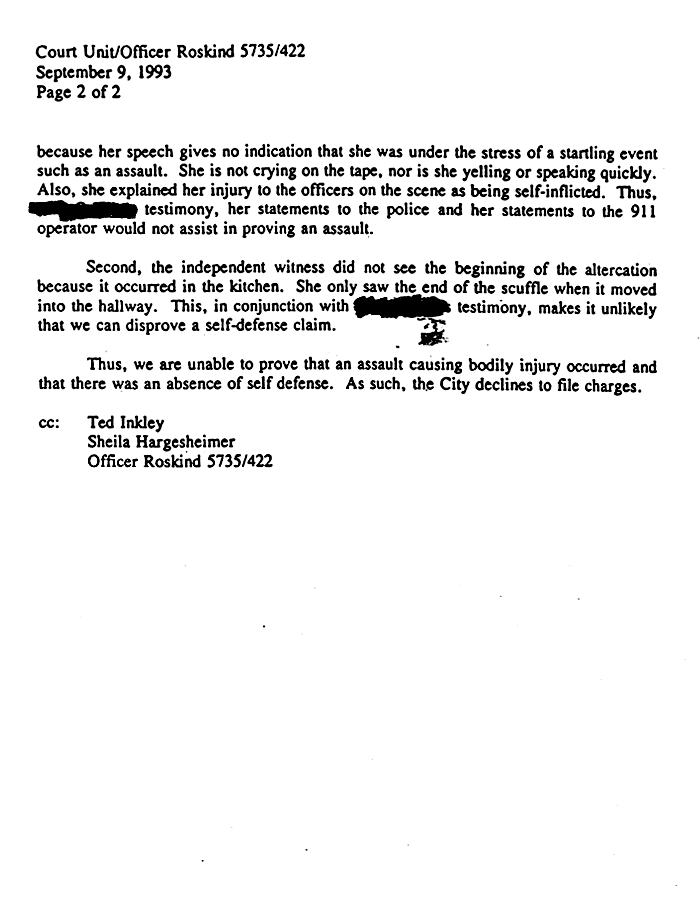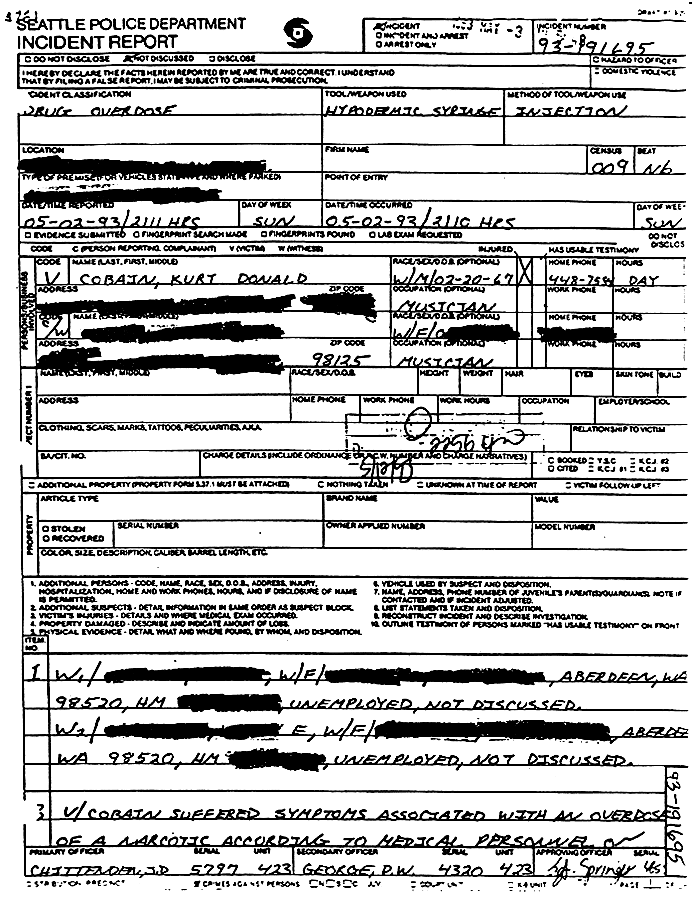
The circumstances surrounding Kurt Cobain’s Death
Painting a Picture

courtney loves connections
COURTNEY LOVE IS ONE OF AMERICA’S MOST CONTROVERSIAL CELEBRITIES. SHE IS FAMOUS FOR HER PUNK ROCK MUSIC, HARD DRUG USE AND THE MANY ACCUSATIONS OF FOUL PLAY THAT SURROUND THE ALLEGED SUICIDE OF HER LATE HUSBAND, KURT COBAIN.
MOST PEOPLE DO NOT KNOW ABOUT COURTNEY LOVE’S LONG AND SPECIAL RELATIONSHIP WITH SEATTLE LAW ENFORCEMENT A RELATIONSHIP THAT COMPROMISED THE INVESTIGATION INTO HER HUSBAND’S DEATH, AND PERHAPS RUINED ANY CHANCE OF EVER KNOWING WHAT REALLY HAPPENED TO KURT COBAIN.
THE SPD’S LEAD DETECTIVE, SGT. DON CAMERON, COURTNEY’S FRIEND, CONCURRED SHE TOLD TOM GRANT (THAT SHE HIRED TO FIND KURT) SHE GOT “BROWNIE POINTS” FOR TIPPING OFF HIS COLLEAGUE, NARCOTICS DETECTIVE ANTONIO TERRY, ABOUT SEATTLE DEALERS, SOME OF THEM HER OWN. IN TURN, CAMERON PROVIDED HER HELPFUL PROFESSIONAL ADVICE. WHEN SHE SHOWED HIM KURT’S ROME “DIVORCE” LETTER, CALLING IT SUICIDAL, THE DETECTIVE ADVISED HER, ACCORDING TO WALLACE AND HALPERIN, “THIS WILL NEVER DO YOU ANY GOOD. I’D GET RID OF THIS IF I WERE YOU.”
Matthew Richer
Recently, investigative journalist Matthew Richer unearthed a more complete version of the March 18th disturbance call when he contacted Seattle Police Department Detective Everett Edwards for an interview.
A veteran of the force 21 years, Detective Edwards is recognized throughout the Seattle community. His current position is the detective in charge of the Seattle Police Department’s Property Recovery Unit.
He was the first patrol officer on the scene at Lake Washington that fateful evening on March 18th, 1994.

THE NOTE
Suicide note:

Was the letter also a suicide note?
Grant claims that while he was working for Courtney Love he came across the suicide note that Cobain wrote for Courtney Love. He believes that the letter reads as a note announcing he is leaving his wife and the music business.
not as a farewell to life.
He claims the final few lines at the bottom – which do imply suicide – were added afterwards by an unknown individual.
But the more Tom Grant discovered, the more he became convinced that the official cause of death was wrong. Grant believes that he found important inconsistencies in the case. For instance, Grant said Cobain’s credit card appeared to have been used after his death:
“There was an attempt made on April 6, there was another attempt made on April 8th. Kurt had died sometime on April 5, the previous Tuesday. Who was using the credit card?”
(video from group below) https://www.facebook.com/groups/cobain.conspiracy/https://www.facebook.com/groups/cobain.conspiracy/
Wallet
- Kurt’s wallet was found by medical examiners and re-positioned for a picture of his driver’s license. The wallet was NOT left by Kurt in this position.
But Grant didn’t find Cobain soon enough. His lifeless body was discovered by an electrician working at Cobain’s Seattle home three days after he died. Tom Grant said that the police told him that the death was a suicide:
“I contacted the police the day the body was found. They basically told me on the phone, ‘Hey, we know a suicide when we see a suicide.’
Stool / Door
“Courtney asked us, of course, not to contact him, not to make any contact with him, just to report back where he was and what was going on.”
There has been some controversy because one does not have to be an expert to notice the last lines are written in a different way than the rest of the note. Some claim the gross of the note was a note written by Cobain with no suicide intentions, and that the last lines were forged in order to make the note “a suicide letter”. On April 8th, 1994, the Seattle Police Department made a copy of the note for the Cobain family. The real note was sent to the forensic document examiner of the Washington State Patrol, Janis J. Parker, who spent 2 weeks analysing the sheet of paper. That weekend, Tom Grant asked Cobain’s widow to see the copy of the note. Grant faxed the copy to his phone number, leaking the note to the media. As a result, the leaked note is a copy of the copy of the real note. On April 22nd, 1994 Parker determined that the note was written by Mr Cobain. Since Grant was not satisfied with the results, in 1997 the television show “Unsolved Mysteries” asked expert Reginald Alton to analyse the leaked note. Alton said there was a suspicion of a second hand involved, but “the copies are not good enough to make any firm pronouncement”. As it was stated above, the real note (penned in red ink) is needed to complete the analysis. The meaning of the note has been discussed too. Grant believes that the gross of the note was a retirement letter because Cobain shares how he felt like a rock star. However, Cobain not only expresses concerns about his career in the music business, but he also shares details of his family (wife and daughter) and of his persona (feeling hate and empathy towards all humans), information the casual Nirvana fan does not have to know to understand “a retirement letter”. The following extract does not match the personality of a rational person who just wants to leave a job: “Jesus man! Why don’t you just enjoy it? I don’t know. I have a goddess of a wife who sweats ambition and empathy and a daughter who reminds me too much of what I used to be. Full of love and joy kissing every person she meets because everyone is good and will do her no harm. And that terrifies me to the point to where I can barely function. I can’t stand the thought of Frances becoming the miserable self-destructive, death rocker that I’ve become. I have it good, very good, and I’m grateful, but since the age of seven, I’ve become hateful towards all humans in general. Only because it seems so easy for people to get along, and have empathy. Empathy! Only because I love and feel for people too much I guess“ . There are numerous possibilities to explain why there is a change in handwriting. For example, Cobain wrote the gross of the note while he was sober and added the suspicious lines while being intoxicated. Another possibility is that given Cobain’s ambidextrously he changed his usual writing with the right hand to the left as a consequence, for example, of feeling pain in the right hand. As a conclusion, it can be said that the most rational option, for people who choose to believe in the reliability of pseudo-science, is to believe in what the only expert who has ever analysed the real note determined.
The stool was another piece of evidence that was used in the favor of the suicide theory. The media, and one of the police reports state that stool was propped up against the door to be used as some sort of lock when that was not the case. John Fisk, First responder on the scene says when he arrived the door was locked, but simply by twisting the lock shut and closing the door behind them the door could easily be locked by someone not inside the room.
In March 2014, the Seattle Police Department developed four rolls of film that had been left in an evidence vault. According to the Seattle police, the photographs depict the scene of Cobain’s corpse more clearly than previous Polaroid images taken by the police. Detective Mike Ciesynski, a cold case investigator, was asked to look at the film because “it is 20 years later and it’s a high media case”. Ciesynski stated that the official cause of Cobain’s death remains suicide and that the images would not be released to the public, but in 2016, the images were released. According to a spokesperson for the Seattle police, the department receives at least one request weekly, mostly through Twitter, to reopen the investigation. This resulted in the maintenance of the basic incident report on file.
<p class=”has-text-align-center has-black-color has-text-color has-normal-font-size” value=”<amp-fit-text layout=”fixed-height” min-font-size=”6″ max-font-size=”72″ height=”80″>

‘Lasting Memory’ – The Lake Washington greenhouse was reportedly demolished by 1998. (Photo seattlepi)
MEDIA INVOLVEMENT
The media spread the information that Kurt Cobain left the rehab center, then bought a gun and was suicidal. Kurt wasn’t suicidal and he and his friend purchased the gun before Kurt left. If Kurt wanted to end his own life, why didn’t he do this on the day he and his friend bought the gun? Why wait to go to rehab? And why go to rehab in the first place if he was so ‘suicidal?’
The Seattle Post-Intelligence reported that Cobain “was shot once in the left ear.” But in a nationally televised photo that shows the rear right shoulder of Cobain’s body, not one drop of blood can be seen on Cobain’s white shirt or on the floor around him. If Cobain was shot in the left ear or anywhere else on his head, the right side of his body should have been covered with blood. Despite these inconsistencies, Dr.Hartshorne, issued a death certificate citing as cause of death a “perforating gunshot wound to the head (mouth).” If this is true, all the blood must have exited from the left side of his body. More importantly, this specious death certificate allowed Courtney Love to cremate Cobain’s body only one week after it was discovered, thus permanently destroying the most important piece of evidence in the investigation. In response to media incredulity over the mystery wound, in June 1994 the medical examiner’s office modified its verdict by saying that there actually was “no exit wound” and that “all of the shot stayed inside the skull.” Dr. Hartshorne and his colleague Dr. Donald Reay then released a remarkable document that says Cobain suffered both a “contact penetrating shotgun wound to the head” and a “contact perforating shotgun wound to the head.” But a “penetrating” wound is one where the bullet enters, but does not exit the body. A “perforating” wound is one where the bullet both enters and exits the body. Why couldn’t they make up their minds?
MISSING PERSONS REPORT
.Love had filed a missing person’s report using her mother-in-law’s name, Wendy O’Connor, on April 4th.
This falsely filed report claimed that Cobain had recently ‘fled’ from drug rehab in Marina Del Ray on April 1st, flew back to Seattle, quickly purchased a shotgun, and “may be suicidal.”
MISSING PERSONS REPORT
Love would later admit she filed the report impersonating Cobain’s mother Wendy O’ Connor, which has led some critics of the case to believe that her assertions about her husband’s state of mind may not be accurate, and could also be a convenient red herring for the authorities and media alike.
ROME INCIDENT
More Mythology in Rome?
In another article, published by Rolling Stone Magazine in June of 1994 by the well-known author Neil Strauss, there also appears to be some glaring misconceptions with regard to not only the evening of March 18th – but of Cobain’s accidental overdose in Rome on March 4th, just two weeks before the March 18th police call. The article characterized that Cobain’s overdose in Rome, was a “failed suicide attempt, however, this media analysis differed quite a bit from Dr. Osvaldo Galleta, the attending doctor who treated Cobain:
“We can usually tell a suicide attempt, “He did not seem like a young man who wanted to end it all.” Adding that Cobain, “will fully recover with no lingering problems.”
The Rome incident, has often been cited as additional evidence of Cobain’s alleged ‘mental state’ and in many ways, it has also been grafted onto the events of March 18th and his eventual death, but without any serious qualification. This becomes even more clear, when you consider the Rolling Stone article written by Strauss, confidently proclaiming that the “domestic dispute escalated into a near disaster,” on the evening of March 18th. Both the incident in Rome and the March 18th disturbance call, set the stage for an intervention held for Cobain on March 25th. How much of a factor did both events play in Cobain being urged to go to rehab? More recently, with the release of the HBO co-produced documentary Kurt Cobain: Montage of Heck (MOH) this past May, viewers were given a glimpse into the private life of Cobain via archival footage and other previously unreleased material. Although the ‘authorized’ documentary-drama had been billed by its creators as a celebration of Cobain’s life, the film was laced with what seemed to be heavy speculative commentary and well-edited emotionally charged interviews – all focusing on Cobain’s perceived ‘suicidal’ tendencies – without ever challenging, much less mentioning, the forensic details of the singer’s death.
Cobain, lead singer and guitarist for the grunge rock band Nirvana, was found dead Friday at his Seattle home of a self-inflicted shotgun blast to the head.
Cobain, 27, went into a coma for nearly 24 hours after the Rome overdose. His record company, David Geffen Co., said he inadvertently overdosed on a mix of prescription medication and alcohol while suffering from severe influenza and fatigue.
The Times said Cobain, a sensitive man uncomfortable with his stardom, took drugs like low-level opiates, tranquilizers and, at times, heroin, to block depression and ease stomach pains that plagued him for years and were aggravated by touring.
On March 18, after Cobain had returned to his luxury home overlooking Seattle’s Lake Washington, he locked himself in a room, and Love told police she feared a suicide.
Police found three pistols, a rifle and 25 boxes of ammunition, but Cobain denied he was suicidal and told officers he had locked himself in the room after an argument with Love. Police confiscated the weapons, but took no other action.
Love went to Los Angeles on March 25 to prepare for the release of a new album by her band, Hole. She urged Cobain to come with her and check into a recovery program.
He initially stayed in Seattle, the Times said, but gave in and on March 28, checked into a recovery program at Marina del Rey, Calif.
Three days later, he left the facility without warning. Love, fearful that he was in a suicidal depression, hired private investigators to find him, but they were unsuccessful, the newspaper said.
Cobain’s body was discovered Friday by an electrician who had come to install a security system in his home.
Police said the shotgun Cobain used to kill himself was lent to him by a friend. They said the friend, who wasn’t identified, purchased the gun with Cobain’s money.
In a recent interview, Love told the Seattle Post-Intelligencer that she had become increasingly frustrated with police inability to shut down Cobain’s drug sources.
She said she gave information to Seattle police about a person who regularly provided Cobain with drugs. “It’s like apples in an orchard,” Love said. “It’s falling off the … trees. … The Seattle police won’t do anything about it. I asked them, ‘Don’t you get embarrassed when you (hear) that Seattle is famous for grunge, cappuccino and heroin?’ “
Narcotics Capt. Dan Bryant wouldn’t comment Tuesday on what he described as an ongoing investigation.
More Mythology in Rome?
On April 8th, 1994
Cobain’s body was discovered. It was a Friday. That same afternoon, a police spokesman informed the media that the medical examiner was going to perform toxicology tests to know if there were drugs in Cobain’s system. The spokesman also said that the results were going to be available in about 3 weeks, and since private medical records cannot be disclosed, only officers involved in the investigation and Cobain’s relatives were going to know them. On April 13th, the Seattle Post-Intelligencer, a Seattle based newspaper, claims to have spoken with a source close to the investigation. The next day, an article with the headline “Cobain lay dead for 3 days” is published claiming the source said Cobain had 1,52 mg/l of morphine in his system and that there were traces of diazepam (Valium). It is possible that the source disclosed the results of the first test, which is instantaneous, but it is impossible that in less than in a couple of days officials knew the exact quantity of morphine present in Cobain’s system. Considering morphine, the substance heroin turns into when metabolized, remains in the system up to 3 days after the last take, and diazepam remains up to 5 days, it is impossible to know if Cobain injected himself a dose of heroin before dying or if his last take was 3 days before his death. Regarding diazepam, Cobain was in a rehab facility in Marina del Rey, CA. In this facility, he was given Valium for the last time in the afternoon of April 1st. It is possible that the traces of diazepam found in his system were just the remains of the Valium ingestion while staying at the rehab facility.
THE SMOKING GUN
nirvanahttp://www.thesmokinggun.com/documents/celebrity/kurt-courtney-no-nirvana
(all the police reports from the months before kurts death & reports of his death)
DET. MIKE CIESYNSKI
I had no involvement in the original investigation aside from taking a taped statement two years after Cobain’s death. I also knew that a couple rolls of 35 mm film, backup evidence photos from the death scene, were never processed. So, I ordered up the case file from our records vault, closed my private office door and read the entire file for the first time One of the original case detectives, Steve Kirkland, had passed away, as did the scene sergeant Don Cameron. Steve and his partner Jim Yoshida were the best homicide detectives in the unit. Jim was retired, so I gave him a call and told him what I was up to. Jim told me that Courtney Love was very cooperative throughout the investigation and that they had spent a lot of time on the case. I asked Jim who had made the decision not to develop all of the film. He said it was Cameron’s call to not develop the film and to have it placed in the records room safe along with the case file so that no one would swipe anything. Obviously, the media attention was making a few folks a little paranoid. Dr. Nikolas Hartshome was the assistant medical examiner who conducted the autopsy. Nick was a great guy who passed away in 2002. When I received the autopsy report I remembered leaning back in my chair and giving a “whoa” after seeing the morphine level Kurt had in his system. It also showed track marks, and there were several grams of black tar heroin left in his kit. Black tar heroin is found on the west coast west of the Mississippi as compared to Brown or white heroin found on the eastern part of the U.S. I knew I had to develop the film. The supervisor of the crime lab grimaced when I explained it was 20 years old. Film becomes deteriorates with each passing year and becomes very brittle — something I know from working old cold cases — and I wasn’t about to let the film get anymore fouled on my watch. We would have to take the film to the sheriff’s photo unit since Seattle Police Department stopped developing 35mm film since transitioning to digital. Once developed, it was obvious the film had deteriorated, leaving a green tint to all of the photos. The note recovered from the scene was examined by a Washington State Patrol Forensic Document Examiner who concluded the note was written by Cobain. Detectives Kirkland and Yoshida had met with Kurt’s mother, Wendy O’Connor, and showed her the note. She had said she believed the note was written by Cobain. Det. Mike Cieysinski is pictured holding the shotgun I also decided to have a look at the shotgun. Some conspiracy theorists had suggested that Seattle Police Department had turned the shotgun over to Courtney Love or had destroyed it. When the rusted weapon was brought to me and after I inspected it, I had a warehouseman photograph me holding the weapon. Did I find any earth-shattering evidence that would change the medical examiner’s conclusion that Kurt committed suicide? No. In fact, I found evidence that strengthened that finding. I located the receipt of the purchased shotgun shells from a Seattle Gun store that matched the time and location where a Seattle cab driver said he dropped off a male matching Cobain’s description after picking him up from the Cobain residence. Also, when I had questions about the positioning of the shotgun found in Cobain’s hand and the location of the spent shell casing, I interviewed an experienced weapons armorer who explained the dynamics of what had likely occurred. Why would a millionaire musician with a bright future of unlimited potential take his own life? I wish we could ask all the the others who have done so who have seemed outwardly “fine.” “He or she would never commit suicide,” is one of the most common things we hear when working a case that turns out to be a suicide. It has been my experience as a homicide detective that depression is the most

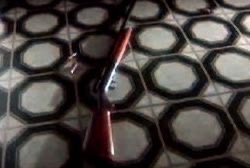
shotgun 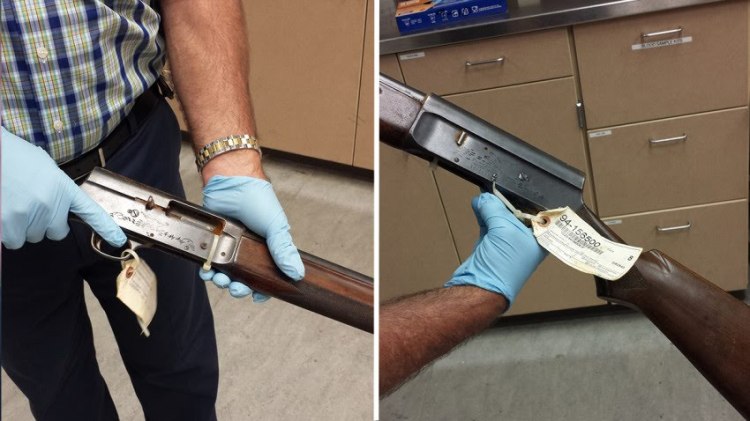

kurt lies with shotgun on chest
commohttps://www.cbsnews.com/pictures/new-kurt-cobain-death-scene-photos/19/https://www.cbsnews.com/pictures/new-kurt-cobain-death-scen reason people commit suicide.https://www.youtube.com/embed/8R5dd-3UUsY?wmode=transparenthttps://www.youtube.com/embed/VRpTXUytG2I?wmode=transparent
Dr. Cyril Wecht
In this interview Dr. Wecht talks about different aspects of his expertise and renders his opinion on the death of Nirvana frontman Kurt Cobain.
The musician died in 1994 at the age of twenty-seven. The official ruling of suicide has been publicly questioned since the week after the news broke of Mr. Cobain’s death.
(1) Why do you believe that Mr Cobain’s death was a homicide staged as a suicide?
I have never seen a case of someone with such an exceptionally high level of heroin, enough to kill a lot of people, who were able to do what the authorities say Kurt Cobain did. It does not make any sense at all from a physiological, neurological or psychological standpoint. Number one, that he would inject himself with such a huge amount of heroin and then take all of the assembly used to inject the drug and clean them and carefully put them back into the special little case: the needle, the syringe, and then set it aside, and then in this state of bliss and contentment, which is why these drug addicts take these drugs – to then pick up the shotgun and shoot himself. It is just absurd. Most of these people die with the needle still in them, the tourniquet on their arm, or the needle and syringe lying close by. Or they recover after a state of unconsciousness. Or they are resuscitated if someone is called to the scene. But for someone to make this injection and then take apart everything and put it back into a case carefully and take a shotgun and shoot themselves, it is just – I have never seen anything like that.
(2) Are you aware of any recorded cases of deceased persons with the blood morphine level comparable to Mr. Cobain’s?
I have seen some cases with a very high level. But this certainly was in a very high range. Of course, addicts develop what is called tolerance and they can handle a much larger dose than people who are not long-term addicts, so it is not the quantity alone. It is the circumstances that go along with that kind of quantity. As I already said, what was there at the scene, and then the commission of suicide itself needs to be considered. If you take the drug, the drug at that level probably is going to lead you into a state of semi-consciousness very quickly. And what is the purpose of taking the drug if you are going to kill yourself? The reason people take these drugs is to make themselves feel much more placid much more contented, to eliminate troubled feelings, their sense of depression, anxiety or whatever it may be. So it just does not fit.
(3) You have also expressed some doubts about the position of the shotgun on Mr. Cobain’s body.
Yes. The position of the shotgun did not fit either with someone having shot himself with a shotgun. That was very important too. When you go to a scene and you have someone who has been found shot you have to be very careful. This leads me to another big point which is that the scene was not at all properly investigated. They made a quick assumption of a very premature nature that it was a suicide. You do not do that. You treat every case as if it were homicide and most of the time it will prove to be a suicide or maybe an accident. The percentage of homicides will below, but you make sure that you treat it as one. You collect everything that you can: footprints, fingerprints, trace evidence, physical evidence, hair, and so on. And then if it all proves to be unnecessary, the only thing is that you have spent some time, some energy. But this was not done, and the scene was not properly investigated.
(4) In your practice how often have you come across staged suicides?
Not frequently, but I have dealt with several over the years. In fact, I will be testifying in one in the next couple of weeks in Philadelphia. So, while they are not frequent, they do occur. It is just not something that you would never see. I have dealt with a couple dozen over the years in which I rendered reports and testified. Could you walk us through the proper procedure of determining the cause and manner of death, the role of the police department and the medical examiner in the process, as well as the sequence and timeline for the process? The procedures are very straightforward. Homicide detectives are called to the scene, not just plain regular cops.
Number two: forensic scientists are called. Criminalists come to the scene before anything is touched or moved. The forensic pathologist if available should go, but certainly a forensic scientist, to look for physical evidence and collect it before anybody else contaminates the scene. Then photographs are taken with everything in place before anything is moved. After all, that is done, and it may take hours, the body is taken to the medical examiner’s office, photographs are taken there, and then the body is examined. Things may be collected for further studying externally like hair and fingernails and so on. And testing is done to see if there is any evidence of the individual having fired a weapon, by testing the hands and fingers and so on. After all that is done, the autopsy is done in great detail, with emphasis, of course,on the shotgun wound itself in terms of the angle, the trajectory and determining the distance that the muzzle would be away from the body.
(5) You walked us through the proper procedure and now how was this procedure not followed in Mr. Cobain’s case?
The scene was not properly investigated by homicide detectives and by criminalists. There was no detailed study and examination of the physical surroundings. The body was just moved and taken to the medical examiner’s office so those things were not done.
(6) What can be done to have this case reinvestigated now?
The legal next of kin would have to become very active in pushing for this. There isn’t any process available to have this case reinvestigated by another agency? No, it would have to come from law enforcement. There is no statute of limitations on homicide, so from a legal standpoint you could revisit, but it would have to emanate from the district attorney or a law enforcement agency. Dr. Nikolas Hartshorne signed Kurt Cobain’s death certificate calling his death a suicide one day after the body was discovered. This was despite the fact that the full toxicology results would not be available for weeks. Hartshorne was employed by the King County Medical Examiner’s Office on a fellowship. He had not yet taken the accreditation examination necessary to become a certified examiner. Hartshorne died in 2002 in a BASE jumping accident. Autopsy reports are not a matter of public record in Washington State, where Mr. Cobain died. Only the next of kin can request their copies. If you had access to Mr. Cobain’s autopsy report either because it was forwarded to you by his family or you found yourself in its possession in some other manner, would you be willing to examine it and render a professional opinion? read the full interview below
Carmen Best
Director Benjamin Statler’s docudrama “Soaked In Bleach” ends with former Seattle Police chief Norm Stamper saying he would reopen the investigation into the death of Kurt Cobain, if he were calling the shots today. But Stamper was the guy in charge from 1994 to 2000, including the time of Cobain’s death. He now insists that Seattle Police should “have taken steps to study patterns involved in the behavior of key individuals who had a motive to see Kurt Cobain dead.” He went on to to say that, “If in fact Kurt Cobain was murdered, as opposed to having committed suicide, and it was possible to learn that, shame on us for not doing that. That was in fact our responsibility. It’s about right and wrong. It’s about honor. It’s about ethics.” Stamper hammered home his point, adding: “If we didn’t get it right the first time, we damn well better get it right the second time, and I would tell you right now if I were the Chief of Police, I would reopen this investigation.” The movie, which is told from the perspective of private investigator Tom Grant, (who was hired by Cobain’s wife Courtney Love to find her husband after he went missing from a rehab center in Los Angeles), is woven together through reenactments of the the hours of recorded conversations between Grant and Love, and interviews with experts who refuse to believe Cobain died by suicide.
The present-day Seattle Police Department do not share their sentiments. Last year, just before the 20th anniversary of Cobain’s death, rumors began flying that authorities were about to reopen an investigation after it was reported they had developed four rolls of film from the crime scene that had been sitting in an evidence vault. While the photos were released to the public, the Seattle PD made it very clear they were not reopening the case. “No change, no developments, no new leads,” a police spokeswoman said, while the department tweeted, “Our detective reviewed the case file anticipating questions surrounding the closed Cobain case as the 20 yr anniversary approaches.”
The movie addressed the undeveloped film and reenacts a scene in which Grant is told the photos will probably never be developed because they “don’t develop photos on suicides.” “Soaked In Bleach” goes on to claim that “by their negligent death investigation,” the Seattle Police:
Allowed Kurt Cobain to be cremated 6 days after being discovered. Waited 30 days to process the shotgun for fingerprints. Gave Courtney Love the shotgun to have it melted down. Allowed the greenhouse crime scene to be torn down and destroyed
(read more in the blog link below)

http://cobainevidenceblog.blogspot.cz/2016/05/washington-state-patrol-declined-to.html
interview with Nick about his thoughts on the movie Rivaling the tabloid documentaries of Nick Broomfield in the realm of boldness and imagination are personal, in house motives which propel him into ever more raw, nervy and in your face moviemaking. Broomfield revealed to me in an intriguing two-way conversation how he casts himself in his own fantasy scenarios as the embodiment of the modern adventurer, in the tradition of guys like Jack London and Melville. But the go for broke director of Heidi Fleiss: Hollywood Madam and Aileen Wuornos: The Selling Of A Serial Killer may have met his match, not to mention his white whale, with Kurt And Courtney. Cobain widow and rocker Courtney Love went on the offensive against Broomfield and nearly succeeded in shutting his showdown through her corporate influences in the rock world. Of course, this just added fuel to Broomfield’s creative mission, and he explained why.
PRAIRIE MILLER:
After going through the whole experience of making Kurt And Courtney, what is your personal take on the reasons behind Kurt Cobain’s death?
NICK BROOMFIELD:
I think that he committed suicide. I don’t think that there’s a smoking gun. And I think there’s only one way you can explain a lot of things around his death. Not that he was murdered, but that there was just a lack of caring for him. I just think that Courtney had moved on, and he was expendable.
PM: Did the process of making this movie change any of your preconceived notions about either Kurt or Courtney?
NB: I fully expected Courtney to take part in the film, and to use it in a positive way to explain a lot of things that were being said about Kurt’s death. And I fully expected her to be very likeable and charismatic, in the same way for example that Heidi Fleiss was in my film about her. I was really astonished when Courtney tried to control the film. You know, with the BBC and MTV, and trying to block me from getting any of the music. I was really astonished and amazed. That gave a lot more credibility to some of the stories that people were saying about her. I thought a lot of the things that were being said were very extreme, but after a while, I came to believe them. And that was directly borne out of my own experiences in making this film. It was really like a diary. I didn’t go into this thinking anything negative at all about Courtney. It was actually made with a lot of reluctance. I mean, for me it would have been much more satisfying to make a film about someone whom I could say, all these bad things are being said, but she’s such a wonderful person. I didn’t get any satisfaction out of making what I believe to be a truthful, but very dark portrait of someone.
PM: Is she still harassing you in any way?
NB: No.
PM: She gave up?
NB: Yeah.
PM: And what about your preconceived notions related to Kurt Cobain?
NB: With him, it was probably the opposite. The people who were close to him were incredibly moved by him. And I think he was a very sensitive character who grew up under very difficult conditions. You know, he grew up in a logging town among big, tough loggers, and he was a very sensitive creature. He was an artist. He wrote poems and painted. He liked to play his guitar and didn’t fit in, and he frequently got beaten up. He didn’t really have a mother past the age of eight or nine and was shunted around between friends and relatives. You know, he was a lonely, unhappy child, and he really moved a lot of people. I think women wanted to mother him. I think there was a heart in him that really cried out for help, and women especially responded to that.
Filmmaker Nick Broomfield,
IᑎTEᖇᐯIEᗯ ᗷETᗯEEᑎ ᑎIᑕK & ᗪYᒪᗩᑎ ᑕᗩᖇᒪSOᑎ
In the film, Kurt and Courtney Nick Broomfield interviewed Dylan Carlson. His introduction to this interview is as follows:
“I found Dylan to be evasive and in a very defensive position. As Kurt’s best friend it was crazy for him to have bought the gun if he thought Kurt was suicidal. At the same time, he didn’t want to appear to be supporting Tom Grant’s murder theory…..”
Broomfield:
And what about his relationship with Courtney?
Carlson:
Um, obviously it was going through turbulence, some turbulence. Whether it was going to end or not we don’t know. I don’t think we ever will, I mean, you know, but I mean all marriages go through their ups and downs.
Broomfield:
Did he ever say anything to you about, I mean, he did say it to plenty of other people…
Carlson:
Said what?
Broomfield:
That he was going to finish the relationship.
Carlson:
Divorce? I mean, he never, he flat out said anything like that or any implication about it to me, you know. I mean, he didn’t even make any hints as far as I know about any kind of divorce or anything like that.
Broomfield:
I mean, it’s like, I’m just saying it’s like, why?…
I mean, if you are his best friend and he didn’t say anything about being depressed or suicidal, he just wanted the gun for prowlers, and that Rome was just an accident, you know, maybe you would think also he could have been murdered?
Carlson:
Mmm, why? I mean, who? I mean, it’s like…..
Broomfield:
Well if you were his best friend and he never said anything about anything being wrong, and he’d seen you just before- you know, maybe Tom Grant is right, maybe he was murdered.
Carlson:
But I mean he doesn’t have to say anything about it being wrong. I mean, it’s like, you know, when you are friends with someone there is like subtler forms of information transfer than just flat out, you know…
Broomfield:
So what did he subtly communicate to you?.
Carlson:
Broomfield:
I’m just trying to get a sense of what he did communicate to you. What you understood.
Carlson:
I mean, the thing is it’s like, the time he would have been communicating any sort of, you know, a sense that he wanted to kill himself was already….was when he came back from Exodus when I didn’t see him, you know.
Broomfield:
But if you bought the gun before he went and you think he was now suicidal.
.. Carlson:
I don’t think he was necessarily like planning to kill himself at that point necessarily, I mean, I don’t know though…I mean…
Broomfield:
It was just a coincidence.
Carlson:
I mean, it’s like if he had been totally like suicidal from the outset he would have used the gun that day probably, you know what I mean, why did he like try to go down and go through treatment?
Broomfield:
Why do you think?
Carlson:
You know, well ’cos there was all the fucking pressure on him to go through treatment. His wife is telling him he needs to go through treatment, his record company, his management, you know. So he goes and he tries to get off drugs and he can’t or he doesn’t want to. I mean it’s like basically, he doesn’t want to cos it’s like, you know, there is no reason for him to get off drugs. You know, it’s not like he’s poverty-stricken and robbing grocery stores to supply his habit.
Broomfield:
But how was Courtney telling him to be off drugs when she was on them anyway?
Carlson:
I dunno, ’cos she was the one who was all gung-ho for him to quit. I mean, they were both constantly like, I mean, trying to hide it from one another. I mean, the most ridiculous example was one time Kurt called me up to get some speed and then the other line rang and I answered the other line and it was Courtney asking me to get her dope, and both of them were like, “Oh, don’t let the other one know (smiles), I mean.
. Broomfield:
I don’t know what I think about the whole murder conspiracy.
Carlson:
NORM STAMPER & THE SEATTLE PD
Put it this way, if I seriously thought Kurt had been murdered, the people… if I thought Courtney was involved or if I thought, they would be dead now, flat out( small laugh.) I would kill them. If I thought that was the case, I mean,…
Broomfield:
But don’t you think it’s curious that if Courtney, as you said, loved Kurt so much, and she was really so worried about him, she knew he had a gun and thought he was suicidal. That she didn’t come up to Seattle to look for him? At this point, Carlson looks thoughtful but says nothing.
𝐸𝓁 𝒹𝓊𝒸𝒽𝑒’𝓈 𝒾𝓃𝓉𝑒𝓇𝓋𝒾𝑒𝓌https://www.youtube.com/embed/2x4jmX6yoTs?wmode=transparent
Filmmaker Nick Broomfield,
Nick & El Duce
Nick Broomfield, deciding to investigate the theories himself, brought a film crew to visit a number of people associated with both Cobain and Love, including Love’s estranged father, Cobain’s aunt, and one of the couples’ former nannielsThe Mentors’ bandleader Eldon “El Duce” Hoke, who claimed that Love had offered him $50,000 to kill Cobain.

Although Hoke claimed that he knew who killed Cobain, he did not mention a name and offered no evidence to support his assertion. However, he mentioned speaking to someone called “Allen” (Allen Wrench), before quickly interjecting, “I mean, my friend”, then laughing, “I’ll let the FBI catch him.”
Broomfield incidentally captured Hoke’s final interview, as he died days later when he was struck by a train in the middle of the night. Although El Duce passed a lie detector test no action was taken & his death was ruled an accident.https://www.youtube.com/embed/QRlxE03c5Rk?wmode=transparent
Arrived carrying Francis no coat
Quick exit

Mr nanny
Courtney with Francis at greenhouse door
Kurt’s body is inside

.
http://cobainevidenceblog.blogspot.cz/2016/05/washington-state-patrol-declined-to.html
NORM STAMPER & THE SEATTLE PD
Police Chief
podcast about kurts death
TᕼE ᑕOᗷᗩIᑎᑕᗩᔕEhttps://www.youtube.com/embed/VAkCi9l3lxU?wmode=transparenthttps://www.youtube.com/embed/uQNetKLvEHg?wmode=transparent
Cali spoke with Kurt
JESSICA HOOPER .
Jessica was at Kurt’s home quite possibly the day he died, and Rene was also a friend. I ran across some entries from Everett True’s book, Nirvana. Check out these excerpts from Cali DeWitt’s girlfriend at the time, Jessica Hopper, and Rene. The excerpts below are from Everett True’s Bookhttps://www.youtube.com/embed/bFYtxlp2IeQ?wmode=transparent
HANK HARRISON
Hank Harrison, Courtney love’s father was not afraid to have his say about what he thinks happened to Kurt, he never openly blames Courtney but believes she was involved. Which he goes to great detail on Kurt & Courtney story in his latest book “love kills” which is a great read for any Nirvana fan.https://www.youtube.com/embed/m-7XveiIFs0?wmode=transparent
COBAINCASE TIMELINE
https://thedemoniacal.blogspot.com/
(Kristen Pfaff)
https://thedemoniacal.blogspot.com/2012/09/june-16-1994-kristen-pfaffs-death-kurt.html?m=1https://www.youtube.com/embed/YddHIePOQjU?wmode=transparenthttps://www.youtube.com/embed/PZxauVTrqrg?wmode=transparent
TRUE CRIME!





